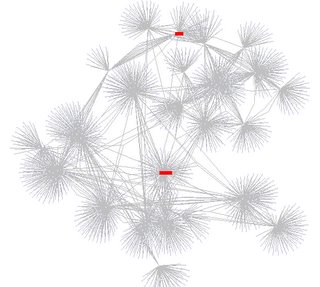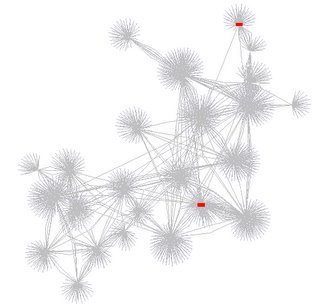 You can pan around, change the dial for time window (weekly on up to quarterly or yearly), and hover over both the bubbles and the text (and sort the text). You can get a detail view of an individual performer in the lower right by clicking on a player. The animation is really nice and you can even change the graph units by direct manipulation. Sweet!
You can pan around, change the dial for time window (weekly on up to quarterly or yearly), and hover over both the bubbles and the text (and sort the text). You can get a detail view of an individual performer in the lower right by clicking on a player. The animation is really nice and you can even change the graph units by direct manipulation. Sweet!
Sunday, April 30, 2006
NY Times' market graph toy
 You can pan around, change the dial for time window (weekly on up to quarterly or yearly), and hover over both the bubbles and the text (and sort the text). You can get a detail view of an individual performer in the lower right by clicking on a player. The animation is really nice and you can even change the graph units by direct manipulation. Sweet!
You can pan around, change the dial for time window (weekly on up to quarterly or yearly), and hover over both the bubbles and the text (and sort the text). You can get a detail view of an individual performer in the lower right by clicking on a player. The animation is really nice and you can even change the graph units by direct manipulation. Sweet!
Saturday, April 29, 2006
Tuesday, April 25, 2006
LiveJournal Social Networks
I believe the latter one shows less network connectivity. I have some stats to support it. Stay tuned...
PS. I used Jeff Heer's prefuse toolkit to make these pictures.
Saturday, April 15, 2006
April is Poetry Month
Berkun blog » Vista and Victimization and More
In The Vista saga: an opinion, Scott gives his take on the delays of Vista at MS and what's being handled well or poorly, from his viewpoint as a former Windows PM. A couple points: "A slip is infinitely better than a panned product." and "Microsoft’s PR and public management of the Vista project has been reactive and weak." Here's a sample:
Centralized authority and MSFT culture. The most comical misperception about Microsoft is the management style - everyone think’s it’s a rigid hierarchy, when it’s mostly a consensus driven place. Everyone gets an opinion and senior managers are often more skilled at consensus management than leading teams. If there’s any one thing I’d point to for large failing projects is lack of successful central authority - With a project in trouble I’d move to centralize power in a smaller number of people and free them to run with the ball. The rub is that the culture doesn’t support this well - people still want a consensus mentality (something born of small team and start-up culture), they want to own their slice, even when it’s contributing to driving projects into the ground (or at least mediocrity). It’s in the fiber of the company and it’s hard to change.
Sinofsky is an inspired move. The MSFT culture, historically, is heavily polarized between Windows and Office. In my day Windows were the smart-ass cowboys who liked risks and breaking rules - not surprisingly Windows had a history of confused early projects that came together only on the home stretch. Office (again, in my day) were stereotypically smart, reliable, consistent A students, who won through plans more than passion. Sinofsky (formerly the Senior VP of Office, now VP of Windows) is the first major attempt I know of to bridge those philosophical and management differences: there’s something to be learned in both directions.
In another recent post, Berkun discusses a fascinating and cynical piece on Victimization Metrics for taking on projects.
Basically the idea is this (a now corrected paraphrase of his post):A = Number of problems you see
B = Number of Problems you don’t have the power to solve
B / A = Victimization ratio.
So if you work in an environment where you can point out 10 problems, but are only capable/empowered to solve 4 of them (so 6 you are powerless on), your victimization ratio is 6 / 10 = 60%.
Not being cynical by nature, Scott adds a couple factors, and inverts the ratio to call it the "empowerment ratio" instead. Nice reading and timely given my current project load. :-)
Finally, his next book is on innovation; he has asked for and gotten a number of recommendations that make interesting reading. (In another post, he summarizes the Amazon sales figures of his project management book over a year as correlated with essay posting and other publicity events --slashdot had the largest influence on Amazon sales figures. Nice.)
Ten things VPs never say
All this entertainment aside, I've known a few nice VPs, especially at Mathworks (hi Roy if you're reading). (And I bet my new CEO would have said some of them as a VP, which is why I like him.)
[Updated to add: A VP reader of Berkun's blog took offense politely and Scott apologized for the stereotyping. One of the interesting things this VP cited was Joel's article The Development Abstraction Layer, about the infrastructure of management that enables delivering code to the customer, and the complexity of making it work well. It certainly made me think about the Design Abstraction Layer, and if/how that works -- but by Joel's analysis it's just a layer in the development management problem, which may in fact be correct thinking. Go read and see what you think.]
plusminus design: flashbag
Sunday, April 09, 2006
You Make Your Own Luck
Principle One: Maximise Chance Opportunities Lucky people are skilled at creating, noticing and acting upon chance opportunities. They do this in various ways, including networking, adopting a relaxed attitude to life and by being open to new experiences.
Principle Two: Listening to Lucky Hunches Lucky people make effective decisions by listening to their intuition and gut feelings. In addition, they take steps to actively boost their intuitive abilities by, for example, meditating and clearing their mind of other thoughts.
Principle Three: Expect Good Fortune Lucky people are certain that the future is going to be full of good fortune. These expectations become self-fulfilling prophecies by helping lucky people persist in the face of failure, and shape their interactions with others in a positive way.
Principle Four: Turn Bad Luck to Good Lucky people employ various psychological techniques to cope with, and often even thrive upon, the ill fortune that comes their way. For example, they spontaneously imagine how things could have been worse, do not dwell on the ill fortune, and take control of the situation.
Tuesday, April 04, 2006
Sunday, April 02, 2006
I Am Hiring
The job is described here: Autodesk Jobs. (It doesn't seem to display well in Firefox, although the gist is clear.) Please pass it on.
Saturday, April 01, 2006
The Physics of Friendship
The gist is that they can model friendship patterns in schools with a system of particle collisions and diffusions, and accurately reproduce the empirical data from a large survey of 84 schools' friendship relations. With a minor variation, the model extends to sexual relations in an HIV study (not at schools).
How depressing to learn we're just particles bumping into each other!
Google Romance

 I nearly fell for one April Fool's post today (Cool Tools, I got too excited by the radio gum), but here's one I didn't (quite) fall for: Google Romance. It's very probable Google is going to be in this space. The storyboard of the two attractive users getting together surrounded by Google community products is obviously a work of realist fiction.
I nearly fell for one April Fool's post today (Cool Tools, I got too excited by the radio gum), but here's one I didn't (quite) fall for: Google Romance. It's very probable Google is going to be in this space. The storyboard of the two attractive users getting together surrounded by Google community products is obviously a work of realist fiction.









